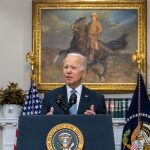Kamala Harris’s team may have prepped the public for a nail-biting presidential contest against Donald Trump, insisting that the drama of the election would unfold over several days. However, just hours after the polls closed across most of the East Coast, it became abundantly clear that the only thing deadlocked was the Democrats’ grasp on reality. Trump’s victory was decided not long after the clock struck eight, tossing Harris’s claims of a drawn-out battle into the trash bin of historical footnotes.
By the next morning, the picture was painted in the stark colors of defeat. Harris, who theoretically occupied the role of an incumbent, had crumbled in all seven swing states, proving that Democrats’ grip on these must-win territories was as sturdy as a paper straw in a hurricane. In Nevada, a state they had reliably claimed since 2008, the trend of Democratic supremacy hit a brick wall, leaving Harris as the second Democratic candidate in three presidential elections to hand Trump an Electoral College victory. The icing on Harris’s sad cake was her staggering defeat by 5 million votes in the popular tally—a stark contrast to her predecessor’s false bravado during campaign season.
In the end, it was the economy, stupid https://t.co/Xw7gmSiuI3 via @dcexaminer
— Randy Mott (@randymot4) November 8, 2024
The crumbling Democratic strategy became evident almost immediately, as party insiders began pointing fingers. Prominent figures, including David Plouffe, thought it prudent to blame President Biden for failing to stick around for what became a historically short reelection bid. Meanwhile, whispers from the Clinton camp suggested that former President Bill Clinton had offered unsolicited advice—cautioning Harris to take Trump’s attacks regarding her camp’s support for taxpayer-funded transgender surgeries for inmates more seriously. Clearly, a campaign undermined by indecision and infighting never stood much of a chance against a well-oiled Trump machine.
The real story, rooted in the economic hardships that gripped the nation under the Biden-Harris administration, shaped the outcome more than any internal squabbles. When voters were asked about their financial situations, the vast majority expressed discontent. In critical exit polls, two-thirds of respondents indicated that the economy was ‘not so good or poor,’ a sentiment that Trump successfully capitalized on, with an impressive 70% vote among this disenchanted demographic. For many, everyday economic struggles were not merely theoretical discussions; they were the lived experiences driving them to the GOP.
Demographic transformations constituted another refreshing development for Trump. In a notable shift, Latino voters started to break from traditional voting patterns. Approximately 70% of Latino Americans rated the economy poorly, with a staggering 85% suffering from the repercussions of inflation. They identified economic issues as paramount, and oddly enough, they turned to Trump—whose appeal among Latinos reached historical heights—garnering nearly half of their votes overall. This wasn’t a demographic that responded well to high-minded rhetoric about equality or social justice; they were concerned about their wallets, and Trump delivered the message that resonated with their palpable frustrations.
As Harris managed to win support among wealthier and more educated voters—those who tend to luxuriate behind closed doors during economic recovery—the working-class youth and those without college degrees shifted vigorously toward Trump. This was not simply a momentary blip but a significant trend revealing that those who had never encountered rampant inflation were suddenly disillusioned by the results of Biden and Harris’s economic policies. While the upper crust of society managed to weather the economic storm, the vast majority of Americans were left out in the rain, choosing to reward Trump’s more reasonable approach to economics.
Ultimately, Democrats miscalculated grossly in believing that they could prioritize inflation-unfriendly policies over the very real financial concerns of ordinary Americans. Many voters have long known the importance of stable prices but saw themselves disregarded as the party moved boldly ahead with plans like the $1.9 trillion American Rescue Plan and the similarly hefty Inflation Reduction Act. The risky gamble of favoring temporary full employment over consistent economic growth came back to bite, leaving Kamala Harris’s already shaky campaign groaning under its own weight—the weight of policies Americans could not ignore. The sentiment among voters was clear: economic stability will always triumph over lofty ideals when it hits home.




